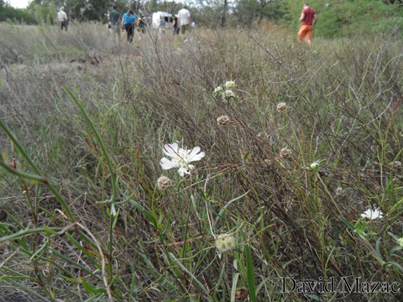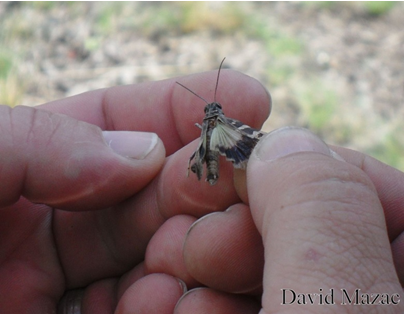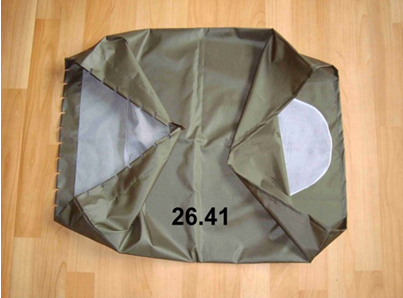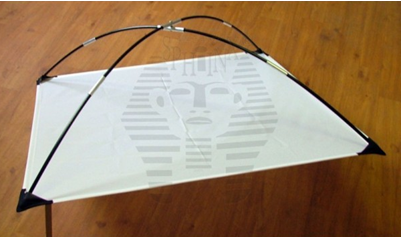2. Collecting Insects from Long Grass and Bushes
30.11.2014
In the first edition of our blog we learned something about the collecting of insects from a general perspective, we described the initial basic methods of collecting as well as the kinds of collecting containers and tools for the temporal storing of a catch. The second edition will present other methods of insect collecting.
 |
| Locality suitable for sweeping |
Sweeping
Very similar to the entomological (butterfly) net, and probably the most common way of collecting insects, is a sweeping net. Just like an entomological net, a sweeping net is composed of:
- a stick (telescopic, one-piece)
- a frame
- a sweeping bag, which is, in comparison to a one-layer entomological net, double-layered. The outer layer sleeve is made from firm textile which protects the softer inner net. The inner layer is attached directly to the frame of the sweeping net. The net is attached to the frame by small metal rings and string. During the sweeping, the inner bag is protected from sharp branches or the wooden stalks of herbs.
 |
| Collecting of insects |
Sweeping is an active way of insect collecting. We hold the sweeping net in front of us and we actively sweep the exposed cover. The sweeping net imaginarily copies the number eight on the ground. Sweeping movements must be fast and energetic in order that the caught insect will not fly away.
During the sweeping, we catch, apart from insects, a lot of plant waste material. From the gathered material it is therefore appropriate to immediately examine, and with an aspirator and forceps to sort out to the collecting bottles.
Sweeping is mostly used for collecting of insects from an herbal level. The net often displays specimens from the tribe Diptera, Orthoptera, and Hymenoptera. From other groups of animals, we are likely to catch spiders from the tribe Araneae.
 |
| A sweeping bag of the diameter 35 cm |
Beating (clapping)
Beating is (just like sweeping) performed on plant vegetation. For collecting from branches, bushes, and lower tree levels anapparatus is used called a clap net. In opposition to sweeping, during beating we can even catch specimens which would otherwise have remained hidden. Clap nets can vary in size, but usually are divided into three types:
- An American sheet is basically just a piece of heavy duty cloth stretched across two diagonal pieces of wood joined at the center
- An umbrella sheet is a piece of cloth fastened to an umbrella construction
- A net sheet is more or less like an entomological net, but with a bigger diameter of frame
Each type has some advantages and disadvantages. Some types of clap nets are easy to manipulate but insects don’t have a hard time escaping from them and vice versa. It is important for the beating sheet to have a large functional surface (usually 1 m2), which ensures a high efficiency of collecting. The beating sheet must be placed under the plant which is being beaten. The insects on the plant will then fall onto the sheet and they must be collected quickly before they can escape. It is recommended to shake repeatedly with the beating sheet so that the insect will have a smaller opportunity of escaping. The beating method of insect collecting is undoubtedly connected with the use of an aspirator which helps with the quick collecting of the caught insects.
The most often collected group of insects with this method is, for example, Heteroptera of Psocoptera. The most efficient time for beating is early in the morning or during cold weather, when daily insects are not that active.
 |
| Clap net |
Author: David Mazáč
Categories
- Novelties
-
Preparation
- Black insect pins
- Stainless steel pins
- Minuten pins
- Plastic headed pins
- Label pins white
- Setting boards for Lepidoptera - LIMEWOOD
- Setting boards of BALSA
- Plastazote setting boards
- Portable suitcase for balsa spreaders
- Pergamine setting strip
- Foam bases
- Pinning block
- Mounting boards
- Sexual boards
- Mounting glues
- For microscopy
- Setting needle
-
Storing equipment
- Portable boxes
- Portable bilateral small suitcases
- Boxes with full lid
- Display boxes
- Entomological wooden display boxes
- Boxes without foam on the bottom for CARTON UNIT SYSTEM
- Carton UNIT trays for CARTON UNIT SYSTEM
- Boxes without foam on the bottom for PLASTIC UNIT SYSTEM
- Plastic UNIT trays for PLASTIC UNIT SYSTEM
- Entomolgical cabinets
- Entomological wooden drawers
- Entomological wooden drawers for CARTON UNIT SYSTEM
- Preservation
-
Field equipment
- Eclectors
- Exhaustor
- Killing fluids
- Syringes
- Butterfly nets and other equipment
- Stopper for killing bottles
- Fillings for killing bottles
- Malayse traps
- Polyethylene killing bottles
- Night field equipment
- Litter reducers
- Butterfly bags
- Aquatic nets
- Tree bark net
- Clap net (Japanese umbrella)
- Sweeping nets and other equipment
- Tree traps
- A Simple Raid Trap
- Other equipment
- Literature
